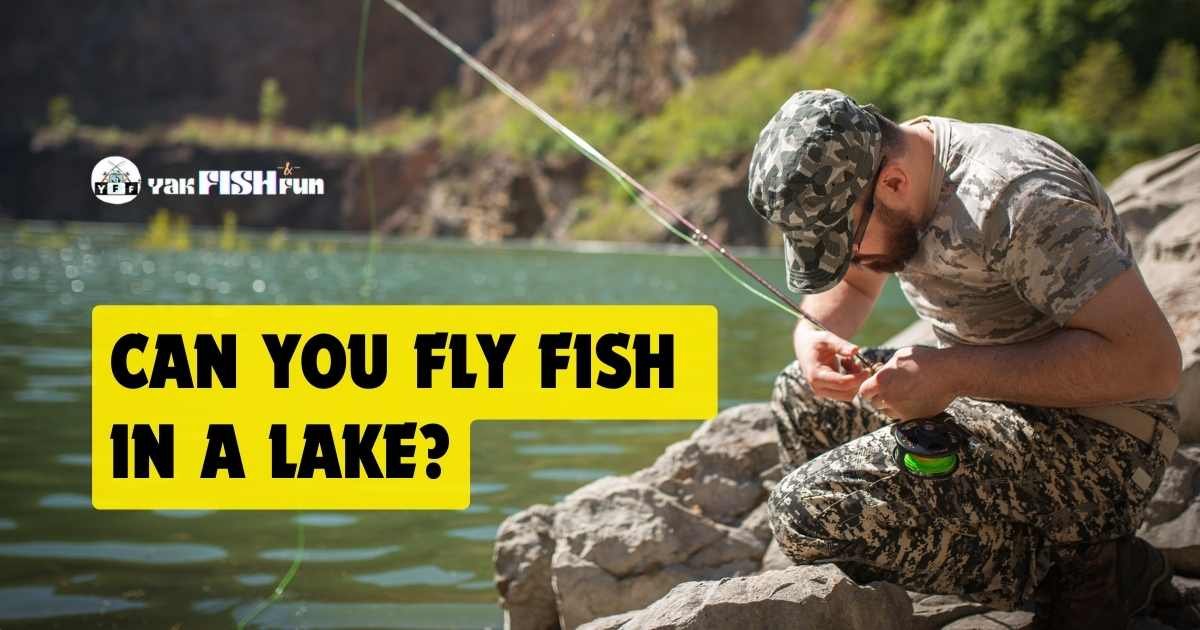When most people think of fly fishing, they imagine casting into a flowing river or stream, but lakes offer a whole different set of opportunities and challenges for fly anglers.
Yes, you can fly fish in a lake. Many anglers enjoy fly fishing in lakes for a variety of fish species.
Fly fishing in a lake, often referred to as Stillwater fly fishing, requires a unique approach and specialized techniques to effectively target fish in these vast, often deeper waters.
Unlike river fly fishing, lake fishing often involves targeting different fish species, such as trout, bass, and pike. Lakes provide a calm and serene environment, perfect for a relaxing day of fishing.
In this post, we will explore the ins and outs of fly fishing in lakes, from selecting the right gear and flies to understanding fish behavior and lake ecology.
Table of Contents

Fly Fishing In A Lake – How Does It Work
Fly fishing in a lake offers a serene and rewarding experience. Cast your line near structures and drop-offs for the best results. Lakes provide diverse fish species, making them ideal for fly fishing enthusiasts.
Fly fishing in a lake is an exhilarating experience, offering a peaceful and scenic environment. Unlike rivers, lakes have their own set of challenges and rewards. Understanding how to effectively fly fish in a lake can enhance your angling skills and increase your chances of success.
Understanding Lake Structure
Lake fishing requires knowledge of the lake’s structure. This helps you identify where fish are most likely to be.
- Shallow Areas: Often rich in vegetation, attracting fish.
- Drop-offs: Sudden depth changes where fish tend to feed.
- Inlets and Outlets: Spots where water flows in or out, drawing fish.
- Submerged Structures: Fallen trees or rocks that provide shelter.
Choosing The Right Gear
Selecting the appropriate gear is crucial for lake fly fishing. Each piece of equipment has a role in your success.
- Rods: A 9-foot rod is versatile for lake conditions.
- Lines: Use floating lines for surface fishing and sinking lines for deeper water.
- Flies: Match your flies to the local insect life.
Techniques For Lake Fly Fishing
Employing the right techniques can make all the difference. Here are some methods to consider:
- Casting: Long casts cover more water, increasing your chances of catching fish.
- Retrieving: Vary the speed to mimic the behavior of prey.
- Drifting: Letting your fly drift naturally can entice strikes.
Best Times To Fly Fish In A Lake
Timing is everything in fishing. Knowing when to fish can lead to better results.
- Early Morning: Fish are more active and less wary.
- Late Evening: Cooler temperatures encourage feeding.
- Cloudy Days: Fish are more likely to be near the surface.
Observing Fish Behavior
Watching how fish behave can offer clues on where and how to fish.
Fish behavior varies with seasons and weather conditions. During summer, fish might stay deeper to avoid heat. In cooler months, they may be closer to the surface. Observing these patterns helps in choosing the right strategies.
Tips For Finding The Right Lake For Fly Fishing
Choosing the right lake ensures a rewarding fly fishing experience. Factors like water clarity and fish species play crucial roles. Optimal conditions make fly fishing enjoyable and successful.
Fly fishing in a lake can be a rewarding experience, but choosing the right lake is crucial. The right location can make all the difference between a successful day and a frustrating one. Understanding what to look for helps you maximize your chances of a great catch.
Water Clarity And Quality
Clear and clean water is essential. Fish are more likely to thrive in such environments:
- Clear water: Fish can see your flies better.
- Good water quality: Indicates a healthy ecosystem.
- Minimal pollutants: Ensures fish are healthy and plentiful.
Fish Species And Population
Different lakes host various species. Knowing what fish are in the lake helps tailor your approach:
- Diverse species: Provides more fishing opportunities.
- Healthy fish population: Increases your chances of a catch.
- Stocked lakes: Offer a higher likelihood of success.
Accessibility And Amenities
Convenience can enhance your fly fishing experience. Easy access and available facilities make a difference:
Lakes with good accessibility and amenities make the experience enjoyable:
- Easy access points: Save time and effort.
- Nearby facilities: Provide comfort and convenience.
- Boat ramps: Offer more fishing locations.
Seasonal Considerations
Seasons affect fish behavior and availability. Understanding these patterns helps plan your trips:
- Spring and fall: Often the best times for fly fishing.
- Seasonal fish behavior: Determines the best approach.
- Local climate: Affects water temperature and fish activity.
Local Regulations
Compliance with local regulations is a must. It ensures sustainable fishing and avoids legal issues:
- Fishing licenses: Required for legal fishing.
- Catch limits: Prevents overfishing.
- Specific rules: May apply to different lakes.
Lake Size And Depth
Larger and deeper lakes offer diverse fishing spots. They can host more fish and provide varied experiences:
- Larger lakes: Offer more fishing locations.
- Depth variations: Provide different fishing environments.
- Fish habitat: Affects where fish are likely to be found.
How To Identify Fish On Lakes
Spotting fish in lakes often involves observing water movement and using polarized sunglasses. Fly fishing in lakes is possible, offering a unique and rewarding experience for anglers.
Understanding how to identify fish can enhance your success. Let’s dive into some practical tips and techniques.
Observing Surface Activity
Fish often reveal themselves through surface activity. It’s a clear indicator of their presence.
- Rising Fish: Fish breaking the surface for insects.
- Swirls and Splashes: Indicates fish chasing prey.
- Ripples: Movement from feeding or swimming fish.
Using A Fish Finder
Technology can be a great ally when identifying fish in a lake. Fish finders can offer precise information.
A fish finder uses sonar to detect fish underwater. These devices display fish locations on a screen, helping you pinpoint hotspots.
Studying The Water Conditions
Different fish prefer specific water conditions. Observing these can help you identify which fish might be present.
- Water Temperature: Some fish thrive in warmer waters, while others prefer cooler temperatures.
- Water Clarity: Clear water may indicate trout, while murkier water could suggest bass.
- Depth: Different species inhabit varying depths.
Noting Vegetation And Structures
Fish love hiding in and around structures. Observing these areas can help you locate them.
- Weeds and Algae: Common hiding spots for smaller fish.
- Rocks and Logs: Larger fish often lurk around these structures.
- Drop-offs: Sudden changes in depth can attract various species.
Watching For Bird Activity
Birds can be a fisherman’s best friend. They often signal where fish are active.
Seagulls, herons, and other birds diving into the water can indicate baitfish presence. Larger fish are usually nearby, taking advantage of the feeding frenzy.
Using Polarized Sunglasses
Polarized sunglasses can significantly improve your visibility in the water.
These glasses reduce glare, allowing you to see fish beneath the surface. They are particularly useful on sunny days when the water’s surface is reflective.
Listening For Fish Sounds
Some fish make sounds that can be heard from above water. This can be an unexpected but useful tip.
- Croaking: Certain species, like catfish, make croaking sounds.
- Splashing: Fish jumping or chasing prey can create audible splashes.
Checking Local Fishing Reports
Fishing reports provide valuable insights into fish activity in specific lakes.
Reports often include recent catches, popular spots, and effective baits. They can save you time and increase your chances of success.
Preparing For Fly Fishing On A Lake
Fly fishing in a lake offers a serene and rewarding experience. Equip yourself with a versatile rod and suitable flies. Embrace patience and enjoy the tranquil waters.
Fly fishing in a lake offers a serene and rewarding experience. With vast, calm waters and diverse fish species, lakes provide unique opportunities for anglers. But, proper preparation is essential to ensure a successful trip. Below are key steps to get ready for lake fly fishing.
Researching The Lake
Understanding the specific lake is crucial. Each lake has its own characteristics and fish species. Gathering information beforehand can make a big difference:
- Local Regulations: Check for fishing rules and permits.
- Fish Species: Identify the types of fish in the lake.
- Seasonal Patterns: Learn about the best times to fish.
- Access Points: Find the best spots to enter and exit the lake.
Essential Gear
Having the right gear enhances your fishing experience. Lake fly fishing requires some specific equipment. Here’s what you’ll need:
- Fly Rod: Choose a rod suited for lake fishing.
- Fly Line: Opt for a floating or sinking line, depending on the lake depth.
- Flies: Select flies that match the local insect life.
- Waders: Wear waders to stay dry and comfortable.
Choosing The Right Fly
Selecting the right fly is vital. Fish in lakes often feed on different insects compared to rivers. Consider these factors:
- Local Insects: Match flies to the insects in the area.
- Water Conditions: Use brighter flies in murky water.
- Fish Preferences: Know the feeding habits of the fish species.
Casting Techniques
Casting in a lake requires a different approach. The vast open space allows for longer and more precise casts. Here are some tips:
- Practice Long Casts: Build your ability to cast far.
- Wind Management: Learn to cast effectively in windy conditions.
- Stealth Approach: Avoid spooking fish with quiet and gentle casts.
Safety Measures
Safety should never be overlooked. Lakes can present unique challenges and risks. Keep these safety tips in mind:
- Weather Awareness: Monitor weather conditions closely.
- Life Jacket: Always wear a life jacket when on a boat.
- Hydration and Snacks: Stay hydrated and energized.
- Sun Protection: Use sunscreen and wear a hat to protect against sunburn.
By following these steps, you’ll be well-prepared to enjoy fly fishing in a lake. Happy fishing!
Baiting Strategies For Fly Fishing On Lakes
Fly fishing in a lake offers a serene and rewarding experience. Effective baiting strategies include using nymphs, streamers, and dry flies. Adapting techniques to mimic local insect life can boost catch rates significantly.
Fly fishing in a lake opens up a new world of possibilities for anglers. It’s a unique experience requiring different techniques than river fishing. Understanding the right baiting strategies can significantly enhance your success.
Understanding Lake Fish Behavior
Fish behavior in lakes differs from rivers. They tend to be more dispersed and can be found at varying depths.
- Seasonal changes: Fish behavior changes with the seasons. In spring, fish are near the surface; in summer, they dive deeper.
- Time of day: Fish are more active during dawn and dusk. Midday can be less productive.
Choosing The Right Fly Patterns
Selecting the right fly patterns is crucial for attracting fish in lakes.
- Nymphs: Effective for fish feeding below the surface.
- Streamers: Imitate small fish and are great for predatory species.
- Dry flies: Ideal for surface-feeding fish during hatches.
Using Depth And Retrieve Techniques
Depth and retrieve techniques can make or break your fly fishing adventure in lakes. Adjusting these based on fish activity is key.
- Vary retrieve speed: Experiment with fast and slow retrieves. Different speeds attract different species.
- Use sinking lines: Sinking lines help reach fish at greater depths. Essential for summer fishing.
Observing Local Insects
Observing local insects can provide insights into what fish are feeding on. Mimicking these insects can improve your chances.
- Match the hatch: Use flies that resemble local insect hatches. Effective during peak feeding times.
- Study the shoreline: Check the shoreline for insects. They often fall into the water and become prey.
Applying The Right Casting Techniques
Casting techniques are equally important. Accurate casting increases your chances of placing the fly where fish are.
Casting accurately and covering a wide area increases your chances of success.
- Long casts: Cover more water and reach distant fish.
- Short, precise casts: Ideal for targeting specific spots with fish activity.
Seasonal Fly Selection
Fly selection should vary with the seasons. Different flies work better at different times of the year.
- Spring: Use bright, flashy flies. Fish are more aggressive after winter.
- Summer: Opt for smaller, natural-colored flies. Fish become more selective.
- Fall: Larger flies work well. Fish are preparing for winter.
Exploring Local Knowledge
Local knowledge can be invaluable. Talking to local anglers can provide insights into effective baiting strategies.
- Visit local fly shops: Get advice on the best flies and techniques for the lake.
- Join local fishing forums: Engage with the community for tips and updates on fish behavior.
Utilizing Technology
Technology can aid in improving your baiting strategies. From fish finders to mobile apps, there are many tools available.
- Fish finders: Help locate fish at different depths.
- Mobile apps: Provide updates on weather and fish activity.
Embrace these strategies to enhance your fly fishing experience on lakes. Each technique offers a unique advantage, improving your chances of a successful catch.
Is Fly Fishing Effective In Lakes?
Yes, fly fishing is effective in lakes. It targets species like trout, bass, and pike. Proper techniques and fly selection improve success.
Can You Fly Fish For Lake Trout?
Yes, you can fly fish for lake trout. Use large streamers and nymphs, targeting deeper waters where they feed.
What Flies To Use On A Lake?
Use woolly buggers, leech patterns, and chironomids for lake fishing. Dry flies like Adams and elk hair caddis work well too.
Bottom Line
Fly fishing in lakes offers a fun and varied experience for anglers. It requires adapting to the unique challenges and opportunities of Stillwater environments. By understanding how lakes work, choosing the right gear and flies, and using effective techniques, you can catch different types of fish. Whether you enjoy the calm of a mountain lake or the thrill of catching a big fish, lake fly fishing is a great alternative to river and stream fishing. With the tips in this post, you’re ready to explore the potential of fly fishing in lakes. So, pack your gear, head to your favorite lake, and enjoy the peaceful adventure of Stillwater fly fishing.


